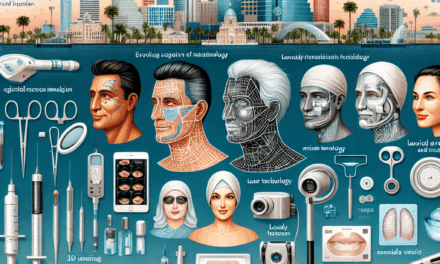Evaluating AI Technologies: Insights from UVA Health’s Analytics Leader
Artificial Intelligence (AI) is revolutionizing various sectors, with healthcare being one of the most impacted fields. As healthcare organizations increasingly adopt AI technologies, understanding how to evaluate these tools becomes crucial. This article delves into insights from UVA Health’s Analytics Leader, exploring the evaluation of AI technologies in healthcare through five key subtopics: the importance of data quality, the role of interdisciplinary collaboration, ethical considerations, real-world applications, and future trends in AI healthcare technologies.
The Importance of Data Quality
Data is the backbone of any AI system, and its quality directly influences the effectiveness of AI technologies in healthcare. UVA Health’s Analytics Leader emphasizes that high-quality data is essential for training AI models that can provide accurate predictions and insights.
Data quality encompasses several dimensions, including:
- Accuracy: Data must be correct and free from errors. Inaccurate data can lead to faulty conclusions and potentially harmful decisions in patient care.
- Completeness: Incomplete data can skew results. For instance, if patient records lack critical information, AI models may not perform optimally.
- Consistency: Data should be consistent across different sources. Inconsistent data can confuse AI algorithms and lead to unreliable outputs.
- Timeliness: Data must be up-to-date. In healthcare, timely data is crucial for making informed decisions, especially in emergency situations.
UVA Health has implemented rigorous data governance practices to ensure data quality. This includes regular audits, validation processes, and the use of standardized data formats. For example, the organization employs a data stewardship model where designated individuals are responsible for maintaining the integrity of specific datasets.
Moreover, the integration of electronic health records (EHR) has significantly improved data quality. EHR systems allow for real-time data entry and updates, reducing the chances of errors associated with manual data handling. UVA Health has leveraged EHR data to train AI models that predict patient outcomes, demonstrating the importance of high-quality data in achieving reliable AI results.
In summary, the quality of data is paramount in evaluating AI technologies. Organizations must prioritize data governance and invest in systems that ensure data accuracy, completeness, consistency, and timeliness to harness the full potential of AI in healthcare.
The Role of Interdisciplinary Collaboration
AI technologies in healthcare require collaboration across various disciplines, including data science, clinical expertise, and IT. UVA Health’s Analytics Leader highlights that interdisciplinary collaboration is vital for the successful implementation and evaluation of AI technologies.
Collaboration can take several forms:
- Data Scientists and Clinicians: Data scientists bring technical expertise in AI and machine learning, while clinicians provide insights into patient care and medical practices. This partnership ensures that AI models are relevant and applicable in real-world settings.
- IT and Compliance Teams: IT professionals ensure that AI systems are secure and compliant with regulations such as HIPAA. Their collaboration with data scientists helps in building robust AI solutions that protect patient privacy.
- Stakeholder Engagement: Engaging stakeholders, including patients and healthcare providers, is crucial for understanding the needs and expectations from AI technologies. This feedback loop can guide the development and evaluation of AI tools.
UVA Health has established interdisciplinary teams that work on AI projects, fostering an environment of collaboration. For instance, when developing an AI tool for predicting patient readmissions, data scientists collaborated with nurses and physicians to identify key variables that influence readmission rates. This collaboration resulted in a more accurate model that could be effectively integrated into clinical workflows.
Furthermore, UVA Health conducts regular workshops and training sessions to bridge the gap between technical and clinical teams. These initiatives promote knowledge sharing and enhance the understanding of AI technologies among healthcare professionals.
In conclusion, interdisciplinary collaboration is essential for evaluating AI technologies in healthcare. By fostering partnerships between data scientists, clinicians, IT professionals, and stakeholders, organizations can develop AI solutions that are not only technically sound but also clinically relevant and beneficial for patient care.
Ethical Considerations in AI Implementation
The integration of AI technologies in healthcare raises several ethical considerations that must be addressed to ensure responsible use. UVA Health’s Analytics Leader stresses the importance of ethical frameworks in evaluating AI technologies.
Key ethical considerations include:
- Bias and Fairness: AI models can inadvertently perpetuate biases present in training data. It is crucial to evaluate AI systems for fairness to ensure equitable treatment across diverse patient populations.
- Transparency: AI algorithms should be transparent, allowing stakeholders to understand how decisions are made. This transparency fosters trust among patients and healthcare providers.
- Accountability: Organizations must establish clear accountability for AI-driven decisions. In cases where AI recommendations lead to adverse outcomes, it is essential to determine who is responsible.
- Informed Consent: Patients should be informed about how AI technologies are used in their care. Obtaining informed consent is vital for maintaining patient autonomy and trust.
UVA Health has implemented an ethical review process for all AI projects. This process involves assessing potential biases in data, ensuring transparency in algorithms, and establishing accountability measures. For example, before deploying an AI tool for diagnostic imaging, the organization conducted a thorough review to identify any biases related to demographic factors.
Additionally, UVA Health engages with ethicists and legal experts to navigate the complex ethical landscape of AI in healthcare. This collaboration ensures that ethical considerations are integrated into the development and evaluation of AI technologies from the outset.
In summary, addressing ethical considerations is crucial for the responsible implementation of AI technologies in healthcare. Organizations must prioritize fairness, transparency, accountability, and informed consent to build trust and ensure that AI tools benefit all patients equitably.
Real-World Applications of AI in Healthcare
AI technologies have numerous real-world applications in healthcare, transforming patient care and operational efficiency. UVA Health’s Analytics Leader provides insights into how AI is being utilized in various domains within the organization.
Some notable applications include:
- Predictive Analytics: AI models are used to predict patient outcomes, such as readmission rates and disease progression. For instance, UVA Health developed a predictive model that identifies patients at high risk of readmission, allowing for targeted interventions.
- Diagnostic Imaging: AI algorithms assist radiologists in interpreting medical images, improving accuracy and efficiency. UVA Health employs AI tools that analyze X-rays and MRIs, helping radiologists detect abnormalities more quickly.
- Natural Language Processing (NLP): NLP technologies are used to analyze unstructured clinical notes, extracting valuable insights for patient care. UVA Health utilizes NLP to identify trends in patient symptoms and treatment responses.
- Operational Efficiency: AI is also applied to streamline administrative processes, such as scheduling and resource allocation. By analyzing historical data, UVA Health optimizes staff schedules to meet patient demand effectively.
One compelling case study involves UVA Health’s use of AI in managing chronic diseases. The organization developed an AI-driven platform that monitors patients with diabetes, providing personalized recommendations based on real-time data. This platform has led to improved patient outcomes, with a significant reduction in hospital visits for diabetic patients.
Moreover, UVA Health collaborates with technology partners to explore innovative AI applications. For example, the organization is piloting a project that uses AI to analyze genomic data, aiming to enhance precision medicine initiatives.
In conclusion, the real-world applications of AI in healthcare are vast and varied. By leveraging predictive analytics, diagnostic imaging, NLP, and operational efficiency tools, organizations like UVA Health are enhancing patient care and improving healthcare delivery.
Future Trends in AI Healthcare Technologies
The landscape of AI in healthcare is continuously evolving, with new trends emerging that promise to reshape the industry. UVA Health’s Analytics Leader shares insights into the future of AI technologies in healthcare.
Key trends to watch include:
- Integration of AI with Telehealth: The COVID-19 pandemic accelerated the adoption of telehealth, and AI is poised to enhance these services. Future AI tools will likely provide real-time decision support during virtual consultations, improving patient outcomes.
- Personalized Medicine: AI will play a crucial role in advancing personalized medicine by analyzing genetic, environmental, and lifestyle factors to tailor treatments to individual patients.
- AI-Driven Drug Discovery: The pharmaceutical industry is increasingly using AI to streamline drug discovery processes. AI algorithms can analyze vast datasets to identify potential drug candidates more efficiently.
- Wearable Technology: The integration of AI with wearable devices will enable continuous health monitoring, providing real-time insights into patient health and facilitating proactive interventions.
- Regulatory Frameworks: As AI technologies become more prevalent, regulatory bodies will develop frameworks to ensure the safe and effective use of AI in healthcare. Organizations must stay informed about these regulations to remain compliant.
UVA Health is actively exploring these trends through research initiatives and partnerships with technology companies. For instance, the organization is involved in projects that integrate AI with telehealth platforms, aiming to enhance remote patient monitoring and care delivery.
Furthermore, UVA Health is investing in training programs to equip healthcare professionals with the skills needed to leverage AI technologies effectively. This focus on education will be crucial as AI continues to evolve and become an integral part of healthcare practice.
In summary, the future of AI in healthcare is promising, with trends such as telehealth integration, personalized medicine, AI-driven drug discovery, wearable technology, and evolving regulatory frameworks shaping the landscape. Organizations must stay ahead of these trends to harness the full potential of AI in improving patient care.
Conclusion
Evaluating AI technologies in healthcare is a multifaceted process that requires careful consideration of data quality, interdisciplinary collaboration, ethical implications, real-world applications, and future trends. Insights from UVA Health’s Analytics Leader highlight the importance of these factors in successfully implementing and evaluating AI solutions.
As healthcare organizations continue to adopt AI technologies, prioritizing high-quality data, fostering collaboration among diverse teams, addressing ethical considerations, exploring real-world applications, and staying informed about future trends will be essential. By doing so, organizations can leverage AI to enhance patient care, improve operational efficiency, and ultimately transform the healthcare landscape.
In conclusion, the journey of integrating AI into healthcare is ongoing, and organizations must remain vigilant and proactive in their evaluation efforts to ensure that these technologies deliver meaningful benefits to patients and providers alike.





